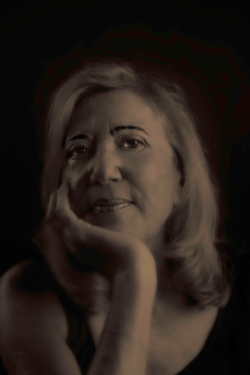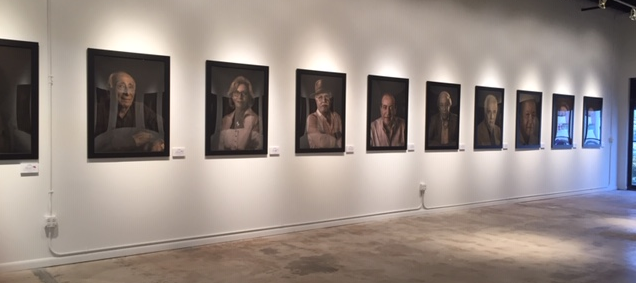Exhibit Review
THE FORGOTTEN EXODUS – AN AMERICAN REFUGE
University of Miami Gallery, Wynwood Building,
Miami, Florida
February 3 - 28, 2020
Reviewed by Annette B. Fromm1
Generally, two elements attract visitors to exhibits: the objects on display and the story they tell. Both of these intersecting components create the substance of what is an exhibition. The Forgotten Exodus – An American Refuge presents twenty-five large-scale, black and white photographic portraits of Jewish individuals originally from North Africa and the Middle East who immigrated to the United States between 1950 and 2015, from Egypt, Iran, Iraq, Lebanon, Syria, Tunisia, and Yemen. All were photographed in South Florida by J. Tomas Lopez, chair of the University of Miami art department.

Michele Karsenti, Born 1947, Tunis, Tunisia, Arrived in USA, 1985
From the point of view of storytelling, a short introductory label informs visitors that the images are “… the last generation of Sephardi Jews born in North Africa, the Middle East, and Iran.” The text continues to explain that the dissolution of many of the communities from which the individuals in the exhibition originated was the founding of the State of Israel in 1948. Some background to the history and significance of the Jews who lived for many thousands of years in Muslim countries is provided in a brief promotional handout.
Labels alongside each photograph provide the name, date, location of birth of the individual pictured, and the date when they arrived in the United States. A regional map highlighting the country of origin is included on each object label; this is a welcome addition since many Americans might not be conversant with North African and Middle Eastern geography. Lacking were the dates when the photos were taken.
The photographs are supplemented with a short video in which several of the people featured in the exhibit tell kernels of their stories. Their reflections about leaving and dislocation add to the storytelling of the exhibition. Photographer J. Tomas Lopez talks about his background and what drew him to photography. He, too, is an immigrant who chose to go into exile and leave his place of birth, Cuba. He expressed many of the feelings shared by the people in his photographs:
“I realized that the story of the Sephardi Jews is the story of every immigrant. You're in a place—you think you're home—and then something happens. There is the displacement, the sense of otherness. I identified very much with everyone I photographed.”
From the point of view of objects displayed in The Forgotten Exodus, the photographs are beautiful images. They are arranged chronologically in the order in which the individuals immigrated to the United States. The first was Emile Wahnich, originally from Morocco, who arrived in 1950. Pierre Benhaim, from Algeria, came some sixty-five years later in 2015. I was left wondering, however, what the relationship was between the departures from their lands of birth and the founding of the State of Israel emphasized in the introductory text, especially since the majority of the individuals reached the U.S. between the sixties and eighties.
In addition, visitors are not informed if these people came immediately to Florida or stopped elsewhere in the United States, much less in any intermediate countries before arriving in the U.S. In the accompanying video visitors learn that Mr. Benhaim and his family emigrated from Marseilles to the United States because of the rise of anti-Semitism in France.
The curators of The Forgotten Exodus, Dr. Henry Green and David Langer, are both principals in Sephardi Voices.2 The goal of this project, initiated by Green, is to create a digital archive documenting the stories of Jews from Muslim lands. I wondered if the exhibit was indeed an outgrowth of the older program, especially because the individuals featured in the exhibit are from North Africa and the Middle East.
The introductory textual statement that The Forgotten Exodus focuses on “… the last generation of Sephardi3 Jews born in North Africa, the Middle East, and Iran” presents a paradox. A few of the individuals featured come from countries settled by exiles from the Iberian Peninsula four centuries ago, what is considered by some the definition of Sephardic. Many of the subjects in the exhibit, however, come from the Middle East with no connection to Iberia. I would have been much more comfortable had the curators referred to the individuals as Jews from Muslim countries.
Furthermore, missing from the exhibition of people living in Florida was insight into the lengthy Sephardic history of the state. Three itinerant Sephardic merchants who worked briefly in Pensacola in 1763 were the first documented Jews in Florida. After a short time, they resettled in the Carolinas and Georgia, where there were active Jewish communities. Almost one hundred years later, David Levy Yulee, the son of Moses Levy, became Florida’s most significant Sephardic Jew. The latter, a descendant of a noted Moroccan Jewish family, purchased land in Central Florida with the intent of creating a colony for persecuted European Jews, Pilgrimage Plantation. As the initiative never drew any settlers, the land became a sugar plantation. When Florida gained statehood in 1847, David Levy Yulee was elected as the state’s first senator. He later supported the state’s secession from the Union. In the late nineteenth and early twentieth centuries, more Sephardic Jewish immigrants made their homes in Florida; settling in north and central Florida they included the Dayan family, originally from Syria, which set up business in Tampa.
During the opening of the exhibit, I visited with Mr. Wahnich, whose photograph was the exhibition’s starting point. I was curious about his story; I learned that he first settled in New York where he worked as a jeweler, the craft he brought from Morocco. Retirement brought him to South Florida. He was aware of a distant relative who long predated him in Florida and the United States. Alfred Wahnish (different spelling), had left Morocco for Boston in 1885. In the 1890s, he moved southward, eventually settling in the Tallahassee area where he established a pioneering tobacco plantation and successful business. His family remains prominent in Tallahassee.
The Forgotten Exodus is a display of twenty-five starkly shown, large-scale photographic portraits. A richer storyline personalizing the images would have made a deeper, more informative exhibition. As shown, it is simply a display of faces isolated from a rich and interesting history.
The Forgotten Exodus was shown at the University of Miami Gallery, Wynwood Building, from February 3 to February 28, extended to March 15, in Miami, Florida.
1 Annette B. Fromm, is a folklorist and lecturer in Romaniote Sephardic studies.
2 For more information see: https://sephardivoices.com/.
3 My emphasis.

